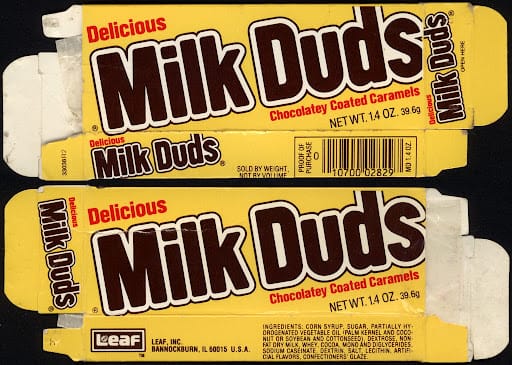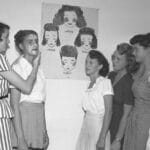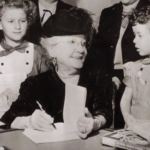Prepare to be amazed as we dive into the world of Milk Duds, a candy that’s been tickling taste buds for ages. We’ll peel back the wrapper on its surprising history, from its unassuming start to its present-day glory. Along the way, we’ll uncover the mysteries behind its name, its debated health effects, the secret to its chewy coating, and even whether it really hides any creepy crawlies. It’s a sweet ride down memory lane, where Milk Duds go from humble beginnings to timeless treat!
History of Milk Duds
Ever popped a Milk Dud in your mouth and wondered, “How did these oddly-shaped, chewy wonders come to be?” Well, buckle up, because the story of Milk Duds is a delightful mix of happy accidents and candy-coated resilience.
From Dud to Stud: The Early Days
Picture this: 1928, Chicago. A confectioner named Edwin Holloway, working at F. Hoffman & Co., envisions a perfectly round, chocolate-covered caramel candy. However, instead of flawless spheres, the candies emerge in a variety of irregular shapes. Some might have seen a factory floor full of rejects, but Holloway saw an opportunity. He embraced the imperfections, playfully dubbing them “Milk Duds” – a nod to their milky caramel centers and their less-than-perfect appearance.
Passing the Candy Cane: A Timeline of Ownership
Over the years, the Milk Duds brand has changed hands numerous times. Beatrice Foods acquired the brand in 1960, followed by Leaf in 1986. In 1996, the chocolate giant Hershey Foods Corporation took ownership, adding Milk Duds to their impressive portfolio. Most recently, in 2018, Highlander Partners acquired Milk Duds, continuing the legacy of this accidental candy creation.
The Ever-Evolving Recipe: A Pinch of This, a Dash of That
Like any good recipe passed down through generations, the formula for Milk Duds has seen a few tweaks over the decades. One notable change occurred in 2008 when Hershey, in a bid to maintain affordability, substituted some of the cocoa butter with less expensive oils. While this decision may have sparked debate among Milk Dud purists, the irresistible combination of chewy caramel and smooth chocolate remains a constant, captivating taste buds worldwide.
The Milk Dud Mystique: Why We Still Love ‘Em
What is it about Milk Duds that keeps us coming back for more? Perhaps it’s the nostalgia factor – that unmistakable taste of childhood memories. Or maybe it’s the unique texture – that perfect balance of chewiness and melt-in-your-mouth goodness. And let’s not forget that iconic yellow and orange packaging, a beacon of joy in any candy aisle. Whatever the reason, Milk Duds have earned their place in the candy hall of fame.
A Sweet Legacy: The Future of Duds
As we look to the future, it’s safe to say that Milk Duds are here to stay. They’ve weathered changes in ownership, recipe adjustments, and even the ever-evolving tastes of candy lovers everywhere. And through it all, they’ve remained a beloved treat, a testament to the simple joy of a chewy, chocolatey indulgence. So next time you pop a Milk Dud, take a moment to appreciate the quirky history and enduring appeal of this accidental candy masterpiece.
Where did Milk Duds originate?
The tale of the Milk Dud takes us back to 1928, in the heart of Chicago. Edwin Holloway, working at the time for F. Hoffman & Co., had a vision for a perfectly round, chocolate-covered caramel confection. However, his vision was met with a slight hiccup. Instead of those perfectly uniform spheres, the candies insisted on emerging in a variety of unique, and somewhat irregular shapes.
Now, one might be tempted to discard such imperfections, but not Holloway. He saw potential in those oddly-shaped treats. Embracing their quirks, he christened them “duds”, a playful acknowledgment of their less-than-perfect appearance. The name, a simple combination of their milk chocolate coating and their “dud” status, stuck. Thus, the Milk Dud was born, proving that sometimes, the most delightful creations arise from the most unexpected circumstances.
Why Are They Called Duds?
Let’s journey back to 1928, the year Milk Duds first graced the candy scene. The original intent was to create perfectly round, bite-sized candies. However, the candies had a mind of their own, stubbornly refusing to conform to a perfectly spherical shape.
Edwin Holloway, the confectioner behind these quirky treats, could have easily given up. However, he decided to embrace their imperfections. The candies were deemed “duds” due to their unconventional forms. The “Milk” part of the name needs little explanation, referring to the sweet milk chocolate that lovingly envelops each chewy caramel center.
Despite their unusual name and somewhat haphazard appearance, Milk Duds were a resounding success! People couldn’t get enough of their unique flavor and satisfyingly chewy texture. The name “Milk Duds” stuck, soon becoming an iconic brand name. What began as a manufacturing glitch transformed into a stroke of marketing genius, demonstrating that imperfection can be quite sweet.
Are Milk Duds Bad for You?
Let’s be honest, Milk Duds are a treat, not exactly a health food. A small handful (about 15 pieces) contains approximately 210 calories and a considerable 27 grams of sugar. You’ll also find about 6 grams of fat, with over half of that being saturated fat.
So, what does this mean for your health?
- Tooth Decay: The high sugar content in Milk Duds can contribute to tooth decay.
- Weight Gain: Those calories can add up if Milk Duds are a regular indulgence.
- Heart Health: Consuming too much saturated fat over time might increase the risk of heart disease for some individuals.
Moderation is Key:
- Portion Control: Instead of finishing an entire box, try enjoying a small handful to satisfy your craving.
- Balanced Diet: Ensure you’re incorporating plenty of fruits, vegetables, and other nutritious foods into your diet.
Milk Duds can be enjoyed as an occasional treat as part of a balanced lifestyle.
What is the coating on Milk Duds?
The chocolatey coating on Milk Duds isn’t your typical chocolate bar coating. It’s a carefully crafted blend of cocoa and vegetable oil. This unique combination delivers that familiar chocolatey taste while ensuring a smooth texture that doesn’t overpower the caramel center.
You might be wondering about the absence of cocoa butter, a common ingredient in most chocolate bars. While cocoa butter provides that melt-in-your-mouth sensation, Milk Duds opt for a different approach. The use of vegetable oil instead of cocoa butter is a cost-effective measure that doesn’t compromise the delicious chocolate flavor.
The perfectly even coating on each Milk Dud is achieved using a special heated drum. Melted chocolate swirls around inside the drum, and those little caramel nuggets take a dip, emerging fully coated in chocolatey goodness. This method ensures a thin and crispy shell, providing a satisfying crunch with every bite.
And speaking of biting, have you ever noticed how Milk Duds aren’t perfectly round? Those bumps and lumps, almost like tiny mountains, are part of their unique charm. Early attempts to produce perfectly spherical Milk Duds were abandoned, and those little imperfections became a distinctive characteristic, making them instantly recognizable.
What are the bugs in Milk Duds?
We’ve all experienced that little crunch when biting into a Milk Dud, leading some to wonder about the source of that satisfying sensation. Rest assured, there are no hidden ingredients lurking within those chocolatey spheres.
The name “Milk Duds” is a bit of a misnomer, referring more to their appearance than their ingredients. The candies are created by mixing caramel and milk, then pouring the mixture into a machine that shapes them into those familiar little balls. However, achieving a perfectly round shape has proven to be a bit of a challenge throughout the candy’s history. The candies often emerge slightly misshapen, like a “dud” in a batch, hence the name.
That satisfying crunch? It’s simply the sound of science at work! When the caramel mixture is initially poured, it’s soft and gooey. As it cools, the sugar molecules begin to solidify, forming a crystalline structure. This process is what gives Milk Duds their signature chewiness. That crunch you experience is simply those sugar crystals making themselves known.
Were Milk Duds an Accident?
The year is 1926. A candy maker is striving to create the perfect chocolate-covered caramel, envisioning smooth, round treats. However, fate, it seems, had other plans. The chocolate coating doesn’t quite cooperate, resulting in some pieces that are a tad…well, “dud”-like in appearance.
Rather than discard these misshapen candies, the candy maker saw potential in their imperfection. These weren’t your average caramels; they had character. Embracing their quirkiness, he named them “Milk Duds.”
The “milk” part of the name is self-explanatory, referring to the milk chocolate coating. But “Duds?” A couple of theories attempt to explain this curious choice. Some believe “dud” was a common term for something that didn’t turn out as planned. Others suggest it might be a playful reference to the difficulty of achieving a perfectly round shape when dipping the caramel in chocolate.
Whatever the reason behind the name, one thing is certain: people loved them! The winning combination of chewy caramel and smooth chocolate, presented in that now-iconic box, was an instant hit. It just goes to show that sometimes, the things we perceive as flaws can become the very qualities that make something unique and wonderful.
Why do Milk Duds hurt my teeth?
We love to indulge in Milk Duds, but sometimes, those chewy treats can leave our teeth feeling a bit sensitive. Let’s explore why.
Milk Duds consist primarily of caramel, and caramel is notoriously sticky. Every time you bite into a Milk Dud, that caramel adheres to your teeth, and unfortunately, our teeth aren’t particularly fond of sugary hugs.
Here’s why: Sugar loves to hang out on our teeth, and it’s a feast for the bacteria that reside in our mouths. These bacteria produce acid as a byproduct of digesting sugar, and acid is not our teeth’s best friend. Acid weakens enamel, the protective shield of our teeth, and that’s how cavities form.
Milk Duds, with their exceptional stickiness, are experts at getting lodged between teeth. Even with diligent brushing and flossing, it can be challenging to remove every last bit of caramel. Those lingering remnants continue to feed sugar-loving bacteria, potentially leading to plaque buildup and an increased risk of cavities.
Here’s the takeaway:
- Sticky Situation: The sticky nature of caramel is the main culprit, promoting the adherence of sugar to teeth and providing a breeding ground for cavity-causing bacteria.
- Trapped! Milk Duds excel at hiding in the nooks and crannies of our mouths, making them difficult to remove completely with brushing alone.
- Sensitive Souls Beware! If you have sensitive teeth, Milk Duds can exacerbate discomfort. The sticky texture can irritate sensitive areas.
Moderation is Key: Enjoying Milk Duds in moderation, as part of a balanced diet, is unlikely to cause significant harm to your dental health.
Where did the term duds come from?
The word “duds,” often used to describe clothing, has a surprisingly colorful history dating back to the late 19th century. While its origins are a bit of a mystery, there are a couple of prevailing theories.
Some believe the term might be linked to the word “dowdy,” meaning shabby or unfashionable. Others speculate that it could be derived from “Dudde,” an old English term for a coarse woolen cloth.
Adding another layer to the puzzle, “duds” also emerged as slang for personal belongings around the same era. This broader use of the word might stem from the notion of clothing as a basic necessity, almost like an extension of oneself.
What Candy is Named After a Girl?
While the origin of the name “Kit Kat” is a subject of debate, it’s intriguing to consider that this iconic candy bar might be named after a real person named Katherine.
The name “Kit Kat” itself has a friendly, almost nickname-like quality. It’s catchy, easy to remember, and evokes a sense of familiarity. Perhaps somewhere out there, a Katherine enjoys a Kit Kat bar, aware that they might share a name with a candy legend.
What chocolate candy was named after a Broadway play?
Junior Mints, those bite-sized bursts of mint and chocolate, have a fascinating connection to the world of theater. Legend has it that James Welch, the creator of Junior Mints, was an avid theater enthusiast.
According to candy lore, Welch was particularly fond of a play called “Junior Miss” that was enjoying considerable success at the time. Inspired, he decided to name his new chocolate-mint creation “Junior Mints” – a playful tribute to the popular Broadway show.
The name proved to be a stroke of marketing genius. Junior Mints quickly gained popularity, becoming a staple snack in movie theaters across the country.
While the story of James Welch and “Junior Miss” is widely circulated, definitive proof directly linking the candy’s name to the play remains elusive. This absence of concrete evidence has sparked debate among candy historians, with some suggesting there might be more to the story.
Perhaps somewhere, hidden away in archives or personal collections, lies the missing piece of the puzzle – a long-lost interview or a forgotten document that definitively confirms the connection between Junior Mints and “Junior Miss.” Until then, it’s fun to imagine Mr. Welch, inspired by a night at the theater, dreaming up a candy that would captivate taste buds for generations to come.
Curious about the rich history of Old Ebbitt Grill? Dive into its fascinating past by exploring our in-depth article on the history of Old Ebbitt Grill.
- SYBAU See You Baby Meaning: Gen Z Slang Evolves - July 1, 2025
- Unlock Your Inner Youth: Lifestyle Secrets for a Vibrant Life - July 1, 2025
- Decode SYBAU Meaning: Gen Z Slang Explained - July 1, 2025







2 thoughts on “Unwrapping the Sweet History of Milk Duds: From Humble Beginnings to Timeless Treat”
Comments are closed.